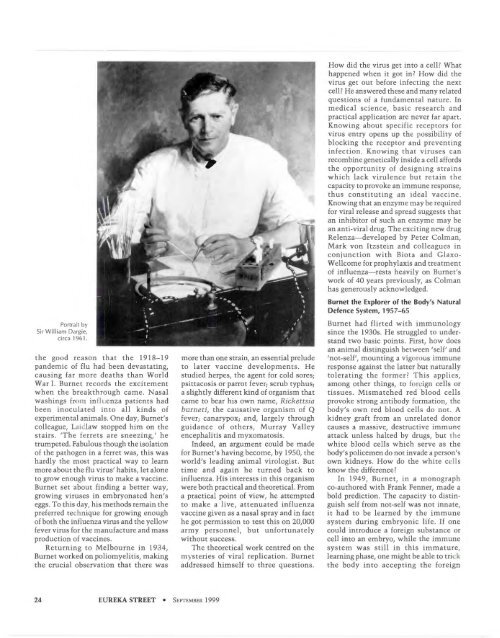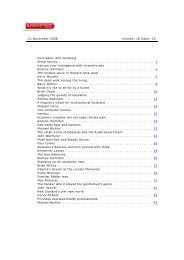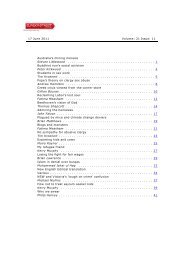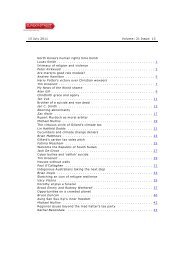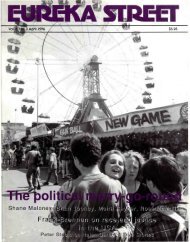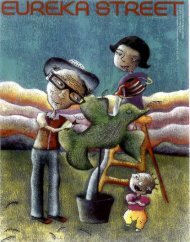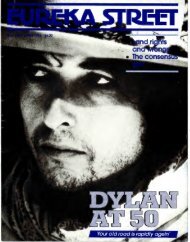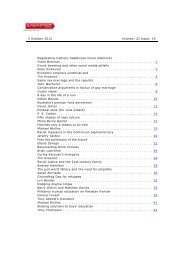1 - Eureka Street
1 - Eureka Street
1 - Eureka Street
- No tags were found...
You also want an ePaper? Increase the reach of your titles
YUMPU automatically turns print PDFs into web optimized ePapers that Google loves.
Portrait bySir William Dargic,circa 196 1.the good reason that the 1918-19pandemic of flu had been devastating,causing far more deaths than WorldWar I. Burnet records the excitementwhen the breakthrough came. Nasalwashings from influenza patients hadbeen inoculated into all kinds ofexperimental animals. One day, Burnet'scolleague, Laidlaw stopped him on thestairs. 'The ferrets are sneezing,' h etrumpeted. Fabulous though the isolationof the pathogen in a ferret was, this washardly the most practical way to learnmore about the flu virus' habits, let aloneto grow enough virus to make a vaccine.Burnet set about finding a better way,growing viruses in embryonated hen'seggs. To this day, his methods remain thepreferred technique for growing enoughof both the influenza virus and the yellowfever virus for the manufacture and massproduction of vaccin es.Returning to Melbourne in 1934,Burnet worked on poliomyelitis, makingthe crucial observation that there wasmore than one strain, an essential preludeto later vaccine developments. H estudied herpes, the agent for cold sores;psittacosis or parrot fever; scrub typhus;a slightly different kind of organism thatcame to bear his own name, Rickettsiaburneti, the causative organism of Qfever; canarypox; and, largely throughguidance of others, Murray Valleyencephalitis and myxomatosis.Indeed, an argument could be madefor Burnet's having become, by 1950, theworld's leading animal virologist. Buttime and again h e turned back t oinfluenza. His interests in this organismwere both practical and theoretical. Froma practical point of view, he attemptedto make a live, attenuated influenzavaccine given as a nasal spray and in facthe got permission to test this on 20,000army personn el, but unfortunatelywithout uccess.The theoretical work centred on themysteries of viral replication. Burnetaddressed himself to three questions.How did the virus get into a cell? Whathappened when it got in? How did thevirus get out before infecting the nextcell I He answered these and many relatedquestions of a fundamental nature. Inmedical science, basic research andpractical application are never far apart.Knowing about specific receptors forvirus entry opens up the possibility ofblocking the receptor and preventinginfection. Knowing that viruses canrecombine genetically inside a cell affordsthe opportunity of designing strainswhich lack virulence but retain thecapacity to provoke an immune response,thus constituting an ideal vaccine.Knowing that an enzyme may be requiredfor viral release and spread suggests thatan inhibitor of such an enzyme may bean anti-viral drug. The exciting n ew drugRelenza-developed by Peter Colman,Mark von Itzstein and colleagues inconjunction with Biota and GlaxoWellcome for prophylaxis and treatmentof influenza-rests heavily on Burnet'swork of 40 years previously, as Colmanhas generously acknowledged.Burnet the Explorer of the Body's NaturalDefence System, 195 7-65Burnet had flirted with immunologysince the 1930s. He struggled to understandtwo basic points. First, how doesan animal distinguish between 'self' and'not-self', mounting a vigorous immuneresponse against the latter but naturallytoleratin g the former? This applies,among other things, to foreign cells ortissu es. Mismatch eel red blood cellsprovoke strong antibody formation, thebody's own red blood cells do not. Akidney graft from an unrelated donorcau es a massive, destructive immuneattack unless halted by drugs, but thewhite blood cells which serve as thebody's policemen do not invade a person'sown kidneys. How do the white cellsknow the difference?In 1949, Burnet, in a monographco-authored with Frank Fenner, made abold prediction. The capacity to distinguishself from not-self was not innate,it had to be learned by the immunesystem during embryonic life. If onecould introduce a foreign substance orcell into an embryo, while the immunesystem was still in this immature,learning phase, one might be able to trickthe body into accepting the foreign24 EUREKA STREET • SEPTEMBER 1999


